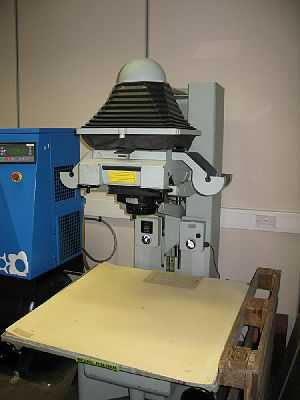Process camera
A process camera is a specialised form of camera used for mass reproduction of graphic materials. The original document was photographed and the negatives produced were used to produce printing plates - usually via some kind of process where the negative was put on top of the printing plate (with a light-sensitive coating) and exposed to light. See Photozincography and Heliozincography for more information on this process.
Producing printing plates via photographic methods was pioneered by Ordnance Survey in around 1893. This process lasted around 100 years before digital technology made it become obsolete very quickly.
Horizontal process cameras
The largest process cameras were typically mounted on a horizontal rail. As with any camera, the section handling the film needed to be separate from the section 'outside' the camera where the photographic subject was placed. This usually meant that these cameras were built in, with the camera having a separate darkroom at the rear. In this darkroom, the film was exposed to the subject and the camera operator controlled the focusing and other settings from here. Newer cameras has automatic presets but the older ones with manual controls required considerable skill to operate. Behind the lens were two frames that were hinged and could be swung into place. Firstly there was a sheet of ground glass that allowed the camera operator to ensure the correct settings for the image. Secondly was the vacuum back, the film (large-format single sheet film) was placed here and held in position by a vacuum pump. Usually, the film was developed into a negative in the darkroom itself.

The other side, or 'outside' of the camera had a rail - either floor-mounted or ceiling-mounted - that allowed precise position of the lens and copyboard. The copyboard was a glass frame, into which the original document was placed. Lights were mounted to the copyboard (to ensure that the amount of lighting was always even) to illuminate the subject. The lens was in a separate frame, connected to the camera back by a traditional 'bellows' type light enclosure. The position of both the lens and the copyboard could be moved on the rail to adjust the focusing and settings - another very common use for the process camera was enlarging or reducing material.

Vertical process camera
Vertical process cameras were and sometimes still are used for smaller material. If a vertical camera were the same size as a large horizontal one then it would take up several storeys of a building, however, for smaller work, the vertical camera is far more space efficient.
Demise of the process camera
Process cameras were still widely in use until the late 1980s and early 1990s. At that time, computer-to-plate technology became economically viable and had significant advantages over the analogue process cameras. There was no need for staff to operate the cameras or expose the negatives and this also meant that the chemicals and film and subsequent expense required for traditional methods were no longer necessary. In some industries, large production areas were replaced by one relatively compact machine - this also having a significant impact on the buildings used for graphic reproduction. As a result, the process camera has become obsolete very quickly indeed and very few remain in use.[citation needed]
